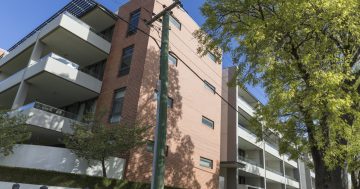
Falling property prices and tighter lending criteria are putting homeowners at risk of being ”mortgage prisoners”. Photo: Michelle Kroll.
Rising interest rates, falling property prices and tighter lending criteria are putting some Canberra property owners at risk of becoming ”mortgage prisoners”. According to investment and advisory group Jarden, an estimated 10 to 15 per cent of borrowers nationally could find themselves stuck with their current lenders.
Clarity Home Loans managing director Mark Edlund said homeowners were considered mortgage prisoners when they didn’t meet a lender’s borrowing requirements to refinance or increase their loan to upgrade their property.
Mr Edlund said people who purchased homes in the past two years, when rates were at record lows and property prices were at their peak, were particularly at risk of being mortgage prisoners.
“Many people took out large home loans while rates were low, with some borrowing at their maximum capacity, and with Canberra having the highest median income in Australia, this contributed to people being approved for larger average loan sizes compared to many other regions,” he said.
“When lenders assess a borrower’s ability to repay a loan, they add a stress test buffer of 3 per cent to advertised rates. A year ago, borrowers would have been assessed on their ability to repay a loan with an average rate of 5.80 per cent. But, if these same borrowers were to refinance today, they would need to be able to show the ability to afford a mortgage with a rate of about 7.9 per cent.”
The higher serviceability rates may mean a person does not qualify for a loan with a different lender, and falling property prices make it even more difficult for homeowners to change banks because the value of their homes has dropped.
National home values fell by 3.5 per cent in the November quarter, with a 3.8 per cent drop in Canberra, where house values dropped 4.2 per cent and unit values were down 2.1 per cent, according to CoreLogic.
Declining home values reduce owners’ available equity – the amount of the property’s value they have paid off.

Clarity Home Loans managing director Mark Edlund. Photo: Liv Cameron.
“If the borrower’s equity is less than 20 per cent of the property value, they will most likely have to pay a lender’s mortgage insurance premium to change lenders, eroding any benefit they would have received by refinancing to a cheaper interest rate with a new lender.”
Mr Edlund said incentives offered by lenders could help.
“Many of our clients are taking advantage of a refinance rebate to offset a possible lender’s mortgage insurance premium. These rebates range from $1000 to $6000 for loans being refinanced.”
Continual interest rate increases have also had a significant impact on people’s ability to build a home, with some Canberrans being forced to consider selling their blocks of land.
“The impact of the interest rate rises has reduced borrowing capacity for construction,” Mr Edlund said. ”When combined with higher building costs, it has put people in a difficult position, with a few unanticipated decisions having to be made – either build a much smaller home than they had originally planned or sell the block and look for an established property.”
If you think you are in danger of becoming a ”mortgage prisoner”, Mr Edlund said it might be wise to consider taking action sooner, rather than later.
“With every cash rate increase by the RBA, your borrowing capacity shrinks, so don’t wait until it’s too late and there are fewer viable solutions available,” he said.
“The first step is to reach out to your mortgage broker or lender to negotiate a lower interest rate on your home loan. Any reduction in your rate will lower your monthly repayments as well as the interest paid over the life of your loan.
“If you don’t have success obtaining a better interest rate with your current lender, it may be time to look at alternative lenders offering a more competitive rate and cash incentives to switch to them.
“While no-one has a crystal ball – and in my experience, most economists seem to be taking a stab in the dark making predictions on interest rate directions – several are predicting further increases throughout 2023.
“Regardless of what the future holds, there is no doubt that over the past six months, we have seen a level of rapid and consecutive rate rises that very few borrowers have ever experienced. This understandably creates a level of uncertainty for homeowners about their ability to meet their loan repayments in the future.”
Mr Edlund suggested borrowers find ways to reduce their expenses and build up their savings to soften the blow of future rate rises as well as increase the likelihood of a successful refinance loan application in the future.
He said borrowers should speak with a qualified mortgage broker who could provide tailored advice based on their situation and offer strategies to alleviate the pain of increasing mortgage repayments.
“There’s no one-size-fits-all solution, so it’s worth getting a trusted professional to help you; a broker can review your financial circumstances and guide you on strategies moving forward.”





















